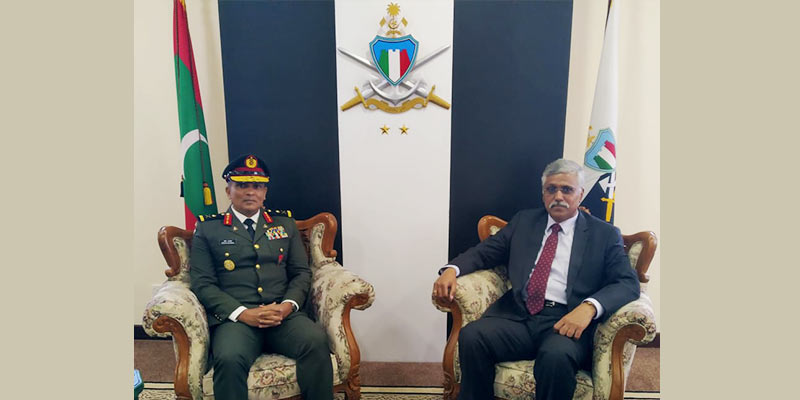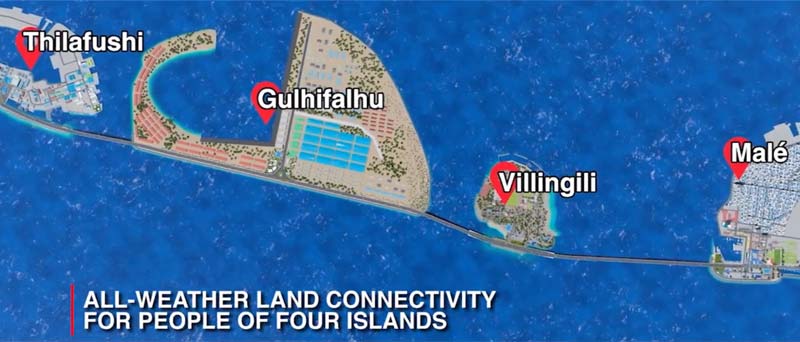- India
- Mar 20
India, Maldives hold 4th Defence Cooperation Dialogue
• India and the Maldives conducted the 4th Defence Cooperation Dialogue (DCD) in Male on March 19.
• The Maldives is one of India’s key maritime neighbours in the Indian Ocean Region and the bilateral defence and security ties have been on an upward trajectory in the past couple years.
• Defence Cooperation Dialogue is the highest institutionalised interactive mechanism between the two countries.
• During the interaction, ongoing bilateral defence cooperation activities were reviewed and both sides expressed satisfaction at the increasing engagements. The talks covered the existing bilateral exercises, with both countries agreeing to increase the complexity of these drills.
• The Armed Forces of India and the Maldives continue to seek bilateral cooperation in multiple fields and the increased engagements are a positive sign for the future of bilateral relations.
India-Maldives relations
• Maldives’ proximity to the west coast of India (it is barely 70 nautical miles away from Minicoy and 300 nautical miles away from India’s West coast), and its situation at the hub of commercial sea‐lanes running through Indian Ocean imbues it with significant strategic importance to India.
• India and Maldives share ethnic, linguistic, cultural, religious and commercial links. Both the nations enjoy close, cordial and multidimensional relations based on shared values of democratic virtues, peaceful coexistence and rule of law.
• India was among the first to recognise Maldives after its independence in 1965 and to establish diplomatic relations with the country.
• Both the countries are key players in maintaining safety and security of the Indian Ocean Region (IOR).
• Maldives occupies a very special place in the ‘Neighborhood First Policy’ and the SAGAR (Security and Growth for All in the Region) vision of the government of India.
• ‘India First’ has been a stated policy of the government of Maldives and President Solih, ever since he assumed office in November 2018.
• Bilateral cooperation with Maldives includes the creation of people-friendly infrastructure – housing, water and sanitation, health and education, ports, roads and stadiums. It also includes maritime security, connectivity and people to people exchanges.
Defence: Since 1988, defence and security has been a major area of cooperation between India and Maldives. India has been assisting Maldives in capacity building by meeting its requirements of defence training and equipment. India provides the largest number of training opportunities for Maldivian National Defence Force (MNDF), meeting around 70 per cent of their defence training requirements. A comprehensive Action Plan for Defence was also signed in April 2016 to consolidate defence partnership.
Trade: India and Maldives signed a trade agreement in 1981, which provides for export of essential commodities. India is now Maldives’ second largest trade partner, with 13 per cent of market share for Indian exports. In July 2021, India extended the agreement on quotas for restriction-free export of 9 essential commodities to the Maldives for next three years.
India‐Maldives bilateral trade crossed the $300-million mark for the first time in 2021, reaching an impressive $323.29 million. Indian imports from the Maldives primarily comprise scrap metals while Indian exports to the Maldives include a variety of engineering and industrial products like drugs and pharmaceuticals, radar apparatus, rock boulders, aggregates, cement and agriculture produce like rice, spices, fruits, vegetables and poultry produce, etc.
To further ease export and import, in July 2021, India’s Central Board of Indirect Taxes and Customs (CBIC) and Maldives Customs Service (MCS) signed a MoU on Pre-arrival exchange of cargo data.
The direct cargo vessel service between India and Maldives started in September 2020 continued its voyages and assisted in keeping the prices low for Maldivian consumers at a time of disruption in supply lines. There is growing trade and commercial ties between India and Maldives.
Tourism: The Maldivian economy is heavily dependent on its tourism sector, which is the major source of foreign exchange earnings and government revenue. Tourism directly accounts for about quarter of the Gross Domestic Product (GDP) of Maldives and indirectly for a much larger proportion of GDP. In terms of direct employment, tourism accounts for more than a third of job opportunities for Maldivians and if the allied sectors are included, the contribution of tourism sector in total employment (direct and indirect) would rise up to nearly 70 per cent. India was among the top sources of tourists for Maldives in 2020 and 2021, helped by the air bubble arrangement, with more than 60 flights per week.
Greater Male Connectivity Project: In August 2022, the India-funded Greater Male Connectivity Project (GMCP), billed as the largest infrastructure initiative in the island nation was kick-started. The GMCP is the largest infrastructure project ever undertaken in the Maldives and it is one of India’s largest projects in the neighbourhood. Under the project, a 6.74 km long bridge and causeway link will be built to connect the capital city Male with adjoining islands of Villingili, Gulhifalhu and Thilafushi.
Manorama Yearbook app is now available on Google Play Store and iOS App Store


